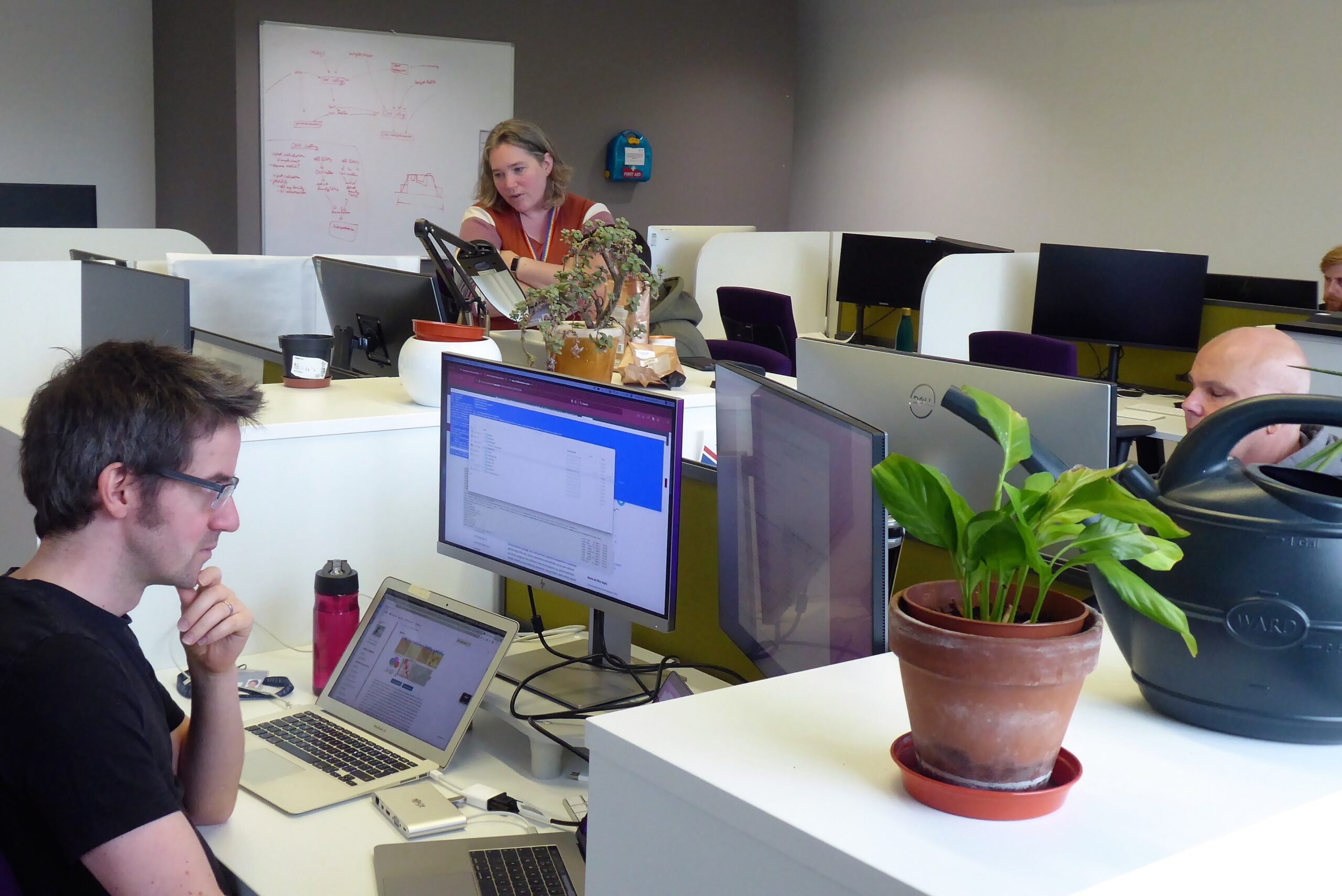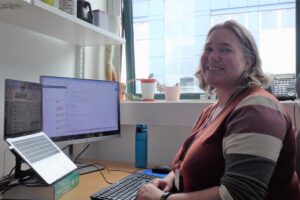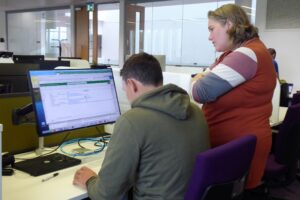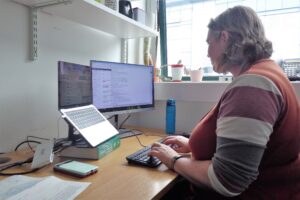Come talk to us early, come talk to us often

It’s late August and the last of the summer sun is peeping in from behind the window as I speak with Alison Meynert, the Manager of the Bioinformatics Analysis Core (BAC) Facility. It provides advice, training, the provision of computational tools and collaborative expertise to all Institute of Genetics and Cancer researchers.
The facility provides computational analysis support to research groups in the IGC and is home to 6 other team members – 5 full-time and one half-time. They also host a university facility which is their model for offering paid services to commercial or non-academic users.
Team Introductions
 Alison’s team are long-standing, knowledgeable staff, with the longest team member, Philippe Gautier, being around since the start, over 20 years ago! They’re mostly bioinformaticians, which means they analyse sequencing, expression, metabolomic and proteomic data. Alison’s team help users figure out how many samples they need, how deep the sequencing needs to be and then they’ll help users analyse the data. Sometimes, Alison’s team will analyse the data themselves and pass results back and forth with facility users. Analysis could be anything from identifying genetic variants to transcriptomics. The BACs team mostly works on bulk cellular samples but do some single-cell sample work too.
Alison’s team are long-standing, knowledgeable staff, with the longest team member, Philippe Gautier, being around since the start, over 20 years ago! They’re mostly bioinformaticians, which means they analyse sequencing, expression, metabolomic and proteomic data. Alison’s team help users figure out how many samples they need, how deep the sequencing needs to be and then they’ll help users analyse the data. Sometimes, Alison’s team will analyse the data themselves and pass results back and forth with facility users. Analysis could be anything from identifying genetic variants to transcriptomics. The BACs team mostly works on bulk cellular samples but do some single-cell sample work too.
The team also have a statistician who (unsurprisingly) helps them work on anything complicated statistically! Last but not least, they have a bioinformatician who also acts as a training coordinator. Training is a thing that Alison believes is one of their biggest successes. Curiosity got the better of me and I asked to learn more…
Training
 Alison was happy to oblige. “The BAC facility offers a wide range of training to help people analyse their own data, both in workshop form and by mentoring people through analysing their data themselves. My team works on the second floor of the main IGC building. There are a couple of hot desks next to my team and staff or students can work with one or two assigned team members as a point of contact. The hot desks can be used for as long as needed! It could be just a few hours. It could be a few weeks. Users can work through analysing their data whilst being able to ask questions of the team who are right there.
Alison was happy to oblige. “The BAC facility offers a wide range of training to help people analyse their own data, both in workshop form and by mentoring people through analysing their data themselves. My team works on the second floor of the main IGC building. There are a couple of hot desks next to my team and staff or students can work with one or two assigned team members as a point of contact. The hot desks can be used for as long as needed! It could be just a few hours. It could be a few weeks. Users can work through analysing their data whilst being able to ask questions of the team who are right there.
“In particular, it’s been useful for PhD students, so they can fully own their PhD projects. This allows PhD students to be able to defend everything that’s done from the design of their experiments right through to the analysis of their results. If they’re doing high throughput sequencing work and they’ve never done anything computational before, that can be quite intimidating. So, they might take some of our workshops and then analyse the data themselves with support. We find that’s successful. PhD students then leave the IGC with a broader skillset than they would have otherwise. They can then bring that experience into their future careers, whatever they choose to do afterwards. It upskills the postdocs too. They can take what they learn back into their lab and help support their team with smaller bioinformatics problems.”
“That means we can focus our skills on anything that’s big or complicated”, Alison concludes. Naturally, my next question was about the most interesting and complex topics she’s worked on.
Case Studies
 “We’re involved in a very long-running collaboration with Charlie Gourley, Ailith Ewing, and Colin Semple. It’s a massive project sequencing and analysing high-grade serous ovarian cancer samples from patients that Charlie’s been collecting over the years. It’s been about 5 or 6 years since we started and we brought in data from all sorts of other sources we could find. It’s led to some really lovely results. We’ve got a paper or two out of it and now we’re trying to get the big paper together. The paper Ailith wrote has potentially given a whole new reason why you might want to use a particular drug against ovarian cancer. Some patients don’t have the classical set of mutations that you would expect, they have a different type of mutation. Our analysis shows that their mutations are equally vulnerable to this drug. The data has been analysed cleanly and consistently and we’re always looking to bring in more as other research groups around the world release data that we can use and integrate it into our project.”
“We’re involved in a very long-running collaboration with Charlie Gourley, Ailith Ewing, and Colin Semple. It’s a massive project sequencing and analysing high-grade serous ovarian cancer samples from patients that Charlie’s been collecting over the years. It’s been about 5 or 6 years since we started and we brought in data from all sorts of other sources we could find. It’s led to some really lovely results. We’ve got a paper or two out of it and now we’re trying to get the big paper together. The paper Ailith wrote has potentially given a whole new reason why you might want to use a particular drug against ovarian cancer. Some patients don’t have the classical set of mutations that you would expect, they have a different type of mutation. Our analysis shows that their mutations are equally vulnerable to this drug. The data has been analysed cleanly and consistently and we’re always looking to bring in more as other research groups around the world release data that we can use and integrate it into our project.”
“We’re also part of two big Covid research consortia ISARIC-4C and GenOMICC, led by Kenneth Baillie from the Roslin Institute. He’s an affiliate with the HGU and our team has been supporting their research to understand the genetic mechanisms behind people’s susceptibility to severe Covid.“
“I’m also very proud of the work we do with the NHS, as part of our university facility. We work with them to support their rare disease diagnostics. They sequence families where there is a child with a rare developmental disorder. We analyse that data and send them back a small set of candidate genetic variants that could have caused the disorder in that child. Then, they validate it and prepare diagnostic reports to go back to the clinician, and so the parents. We’ve been running that for a few years now and there must be over 1,000 families we’ve processed. While the diagnostic rate is hovering at just under 40%, which is normal for this sort of analysis, that’s still 400 families who now know that wouldn’t have known before, and we’ve been part of that.”
“They’ve been really nice projects to be involved with and it’s the same sort of thing that we’ve done before. We’ve been the backbone through data integration, cleaning and analysis. Basically, going from raw data to interpretable data, that’s a lot of what we do”, Alison concluded.
Getting in touch
After speaking with Alison, I discovered many ways the BAC facility can be a valuable resource for staff, students and external users. But how do you get in touch and what advice would Alison have for new users? “Come talk to us early, come talk to us often!” She says enthusiastically. “If you come to us nice and early, we can help you with the design of your experiment. We’ve had several really useful collaborations start that way. By starting early, we can figure out what to do with the budget and samples available to get the most out of it. Talking to us often through the course of a project is also really important too. Don’t just dump some data on us and run away. Keep talking to us.”
“We do have to recover the costs of our core facility. However, we work collaboratively and depending on our contributions and relationship can provide support at a variety of levels. There are lots of ways you can contact us, some of us are on Slack, we’re all on Teams and all our emails are out there. You can also email me, alison.meynert@ed.ac.uk. If you need help with something that you want to do yourself, that’s bioinformatics related, just ask us. We’ve probably run into this problem before and made the same mistake(s).”
More Information
Bioinformatics analysis core | The University of Edinburgh
Dr Alison Meynert on the IGC Bioinformatics Analysis Core Facility | The University of Edinburgh
IGC Student and Staff Members only: Bioinformatics Service – IGC Intranet (ed.ac.uk)



